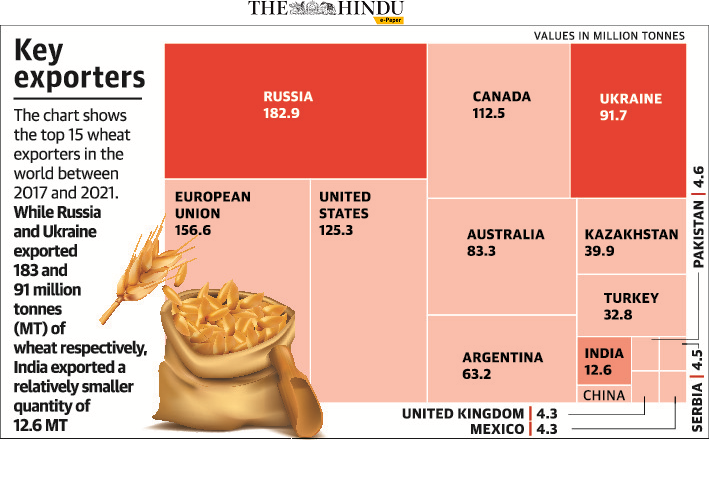From UPSC perspective, the following things are important :
Prelims level: Wheat
Mains level: Indias export of agricultural commodities

Russia and Ukraine account for about 25% of the world’s wheat exports. However, Russia’s invasion of Ukraine and the subsequent Western sanctions against Moscow have curtailed wheat supplies drastically.
India eyeing the global wheat basket
- As a result of War, many countries which were sourcing wheat mainly from these two nations are now in a dire need of alternatives.
- India, the largest wheat producer after China, is reported to be eyeing the void.
- The government plans to allow increased exports to cash in on the higher price of wheat in the international market.
- With harvesting season (March to May) coinciding with the supply crunch, a bumper crop is also expected again this year.
Global wheat scenario
- While Russia and Ukraine exported 183 million tonnes (MT) and 91 MT of wheat, respectively, between 2017 and 2021, India exported just a fraction of its output, or just 12.6 MT, in the period.
- Five other countries accounted for the bulk of wheat exports in this period, including the European Union (157 MT), the U.S. (125 MT), Canada (112 MT) and Australia (83 MT).
- India, which had the second-highest wheat supply (including production, existing stocks and imports) in this period at 613 million tonnes, exported only 2% of this, with about 80% used for domestic consumption, and the rest stored.
Impact of the war
- Many countries in Africa, West Asia and Southeast Asia rely heavily on Russian and Ukrainian wheat.
- Egypt, the biggest importer of wheat, sources 93% of its needs from the East European neighbors. Indonesia, the second-largest importer, has a 30% dependence on these two nations.
- African nations such as Sudan (60% reliance), Tanzania (64%), Libya (53%), Tunisia (52%), and West Asian countries including Lebanon (77% dependency), Yemen (50%) and the UAE (42%) are also highly dependent on supplies from the two neighbors now at war.
India’s focus markets
- India is now focussing on exporting wheat to many nations such as Egypt, Turkey, Nigeria, Algeria, West Asia, Indonesia, Vietnam, Sri Lanka, Bangladesh, Thailand, the Philippines, Morocco and Tanzania.
- To give impetus to the export promotion of wheat as well as to bring focus on the challenges and bottlenecks faced in production and export, APEDA has created a task group.
Legal hurdles over Wheat Exports
- If India decides to export wheat from its stocks, some developed nations may raise objections at the World Trade Organisation.
- Already, in March, India was accused of exporting rice from its stocks.
- India had replied that its rice exports were not from stocks set aside under the public stockholding programs.
India’s consideration
- The Supreme Court in the Right to Food case, observed that the peace clause adopted in WTO’s Bali Ministerial in 2014 does not prevent India from exporting foodgrains.
- With the buffer stocks at hand, India should increase its wheat exports in order to stabilise global prices to the extent that it can.
- It is also important because the countries that were dependent on Russia and Ukraine for their wheat are looking for an alternative source.
Way ahead
- There is a need to prioritise local prices and ensure adequate supplies for domestic consumption before deciding on the quantum of exports.
- Ensuring the stability of prices in India and availability of grain for internal consumption should be of utmost priority to the Indian government
- The government should plan this move in such a way that it does not impact local consumption.
- A bumper crop of wheat is expected, so the government can procure enough for its distribution and buffer needs.
- Further, as of now, there are no export restrictions, so farmers can also get the advantage of higher prices by selling the surplus to private traders for exports.
Try this PYQ from CSP 2019:
Q. Among the agricultural commodities imported by India, which one of the following accounts for the highest imports in terms of value in the last five years?
(a) Spices
(b) Fresh fruits
(c) Pulses
(d) Vegetable oils
Answer is subjective to the year. But still you can give it a try.
UPSC 2022 countdown has begun! Get your personal guidance plan now! (Click here)
Get an IAS/IPS ranker as your 1: 1 personal mentor for UPSC 2024

B
(D) Vegetable oils
D
d